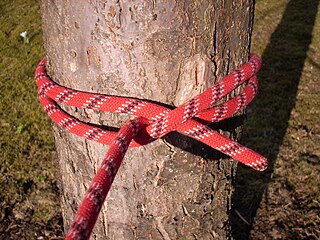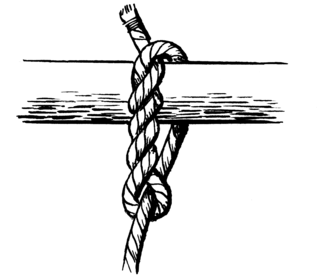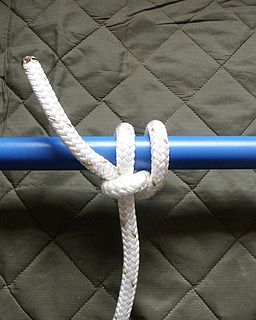
A knot is an intentional complication in cordage which may be practical or decorative, or both. Practical knots are classified by function, including hitches, bends, loop knots, and splices: a hitch fastens a rope to another object; a bend fastens two ends of a rope to each another; a loop knot is any knot creating a loop; and splice denotes any multi-strand knot, including bends and loops. A knot may also refer, in the strictest sense, to a stopper or knob at the end of a rope to keep that end from slipping through a grommet or eye. Knots have excited interest since ancient times for their practical uses, as well as their topological intricacy, studied in the area of mathematics known as knot theory.

The bowline is an ancient and simple knot used to form a fixed loop at the end of a rope. It has the virtues of being both easy to tie and untie; most notably, it is easy to untie after being subjected to a load. The bowline is sometimes referred to as King of the knots because of its importance. Along with the sheet bend and the clove hitch, the bowline is often considered one of the most essential knots.

A miller's knot is a binding knot used to secure the opening of a sack or bag. Historically, large sacks often contained grains; thus the association of these knots with the miller's trade. Several knots are known interchangeably by these three names.

The constrictor knot is one of the most effective binding knots. Simple and secure, it is a harsh knot that can be difficult or impossible to untie once tightened. It is made similarly to a clove hitch but with one end passed under the other, forming an overhand knot under a riding turn. The double constrictor knot is an even more robust variation that features two riding turns.

The clove hitch is a type of knot. Along with the bowline and the sheet bend, it is often considered one of the most important knots. A clove hitch is two successive half-hitches around an object. It is most effectively used as a crossing knot. It can be used as a binding knot, but is not particularly secure in that role. A clove hitch made around the rope's own standing part is known as either two half-hitches or buntline hitch, depending on whether the turns of the clove hitch progress away from or towards the hitched object.
Although the name clove hitch is given by Falconer in his Dictionary of 1769, the knot is much older, having been tied in ratlines at least as early as the first quarter of the sixteenth century. This is shown in early sculpture and paintings. A round turn is taken with the ratline and then a hitch is added below. The forward end is always the first to be made fast.
The difference between two half hitches and the clove hitch is that the former, after a single turn around a spar, is made fast around its own standing part, while the latter is tied directly around the spar.

The water bowline is a type of knot designed for use in wet conditions where other knots may slip or jam.

The taut-line hitch is an adjustable loop knot for use on lines under tension. It is useful when the length of a line will need to be periodically adjusted in order to maintain tension. It is made by tying a rolling hitch around the standing part after passing around an anchor object. Tension is maintained by sliding the hitch to adjust the size of the loop, thus changing the effective length of the standing part without retying the knot.

The timber hitch is a knot used to attach a single length of rope to a cylindrical object. Secure while tension is maintained, it is easily untied even after heavy loading.

The Highwayman’s hitch is a quick-release draw hitch used for temporarily securing a load that will need to be released easily and cleanly. The hitch can be untied with a tug of the working end, even when under tension. The highwayman's hitch can be tied in the middle of a rope, and so the working end does not need to be passed around the anchor when tying or releasing.

An icicle hitch is a knot that is excellent for connecting to a post when weight is applied to an end running parallel to the post in a specific direction. This type of hitch will hold its place even when holding a substantial load on a smooth surface. One can even suspend from a tapered post with this knot.

The buntline hitch is a knot used for attaching a rope to an object. It is formed by passing the working end around an object, then making a clove hitch around the rope's standing part and taking care that the turns of the clove hitch progress towards the object rather than away from it. Secure and easily tied, the buntline hitch will jam when subjected to extreme loads. Given the knot's propensity to jam, it is often made in slipped form.
The buntline hitch, when bent to a yard, makes a more secure knot than two half hitches, but is more liable to jam. It differs from two half hitches in that the second half hitch is inside instead of outside the first one.

The adjustable grip hitch is a simple and useful friction hitch which may easily be shifted up and down the rope while slack. It will hold fast when loaded, but slip when shock loaded until tension is relieved enough for it to again hold fast. It serves the same purpose as the taut-line hitch, e.g. tensioning a tent's guy line.

The rolling hitch is a knot used to attach a rope to a rod, pole, or another rope. A simple friction hitch, it is used for lengthwise pull along an object rather than at right angles. The rolling hitch is designed to resist lengthwise movement for only a single direction of pull.

Two half-hitches is a type of knot, specifically a binding knot or hitch knot. One variety consists of an overhand knot tied around a post, followed by a half-hitch. This knot is less often referred to as a clove hitch over itself, double half-hitch, or full-hitch.
Two half hitches is the commonest of all hitches for mooring in particular and also for general utility. Steel gives the name in 1794. The difference between two half hitches and the clove hitch is that the former, after a single turn around a spar, is made fast around its own standing part, while the latter is tied directly around the spar.
The magnus hitch is a knot similar to a rolling hitch or clove hitch, used to tie a rope or line to a pole, spar, or another line. It is tied similarly to a rolling hitch but with the final hitch in the opposite direction. It can be more tricky to snug up, since both lines emerge from the same side of the hitch, but it has less tendency to twist under load.

The gripping sailor's hitch is a secure, jam-proof friction hitch used to tie one rope to another, or a rope to a pole, boom, spar, etc., when the pull is lengthwise along the object. It will even grip a tapered object, such as a marlin spike, in the direction of taper, similar to the Icicle hitch, and it is much superior to the rolling hitch for that purpose.

The ossel hitch is a knot used to attach a rope or line to an object. It was originally used on Scottish gill nets to tie small line to larger rope that supported the net. Ossel is actually the Scottish word for "gill net" and for the line attaching the net to the float rope.

A pipe hitch is a hitch-type knot used to secure smooth cylindrical objects, such as pipes, poles, beams, or spars. According to The Ashley Book of Knots, a pipe hitch is "used to lower a pipe or hoist one" and as "another method of tying to a rectangular timber."

Swing hitch is a way to tie a swing rope to a branch or other horizontal beam. Ashley describes it in ABOK as "... firm, strong, secure, and easily untied once the load has been removed."
























